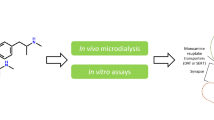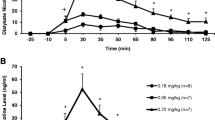Abstract
The effect of chronic oral administration of nicotine on the circadian rhythm of striatal dopamine (DA) and 5-hydroxytryptamine (5-HT) was studied in mice. Mice receiving nicotine in their drinking water and control mice drinking tap water were killed at 05:00, 11:00, 15:00 or 21:00 hours on the 50th day of chronic administration. The plasma concentrations of nicotine and cotinine, as well the striatal concentrations of DA, 5-HT and their metabolites 3,4 dihydroxyphenylacetic acid (DOPAC), 3-methoxytyramine (3-MT), homovanilic acid (HVA) and 5-hydroxyindoleacetic acid (5-HIAA) were estimated. The largest plasma concentrations of nicotine and cotinine were found at 05:00, when they were more than double the concentrations found at the other times studied. This indicates that the mice, typically for nocturnal animals, consumed most of their daily drinking water at night. In the control mice, the striatal DA and 3-MT concentrations showed circadian variation and were lowest at 11:00. The 5-HIAA concentrations also varied, being highest at 11:00. In the nicotine-treated mice the circadian variations in striatal monoamines were altered and more pronounced than in the controls. The concentrations of DA, DOPAC, HVA and 5-HIAA were highest at 11:00 and that of 5-HT at 21:00. The striatal DA, DOPAC, HVA and 5-HIAA concentrations in the nicotine-treated mice were significantly higher at 11:00 and the 5-HT concentrations at 21:00 than in the control mice, and, in contrast to the control mice, in the mice treated with chronic nicotine no circadian rhythm was observed in the 3-MT. No elevation of striatal DA metabolites occurred in the nicotine-treated mice compared with the controls when the plasma nicotine concentration was at its peak at 05:00. This finding suggests development of tolerance to the nicotine-induced changes in striatal DA metabolism. Further, our findings suggest that the chronic administration of nicotine in the drinking water of mice alters the circadian pattern of striatal DA and, to a lesser extent, that of 5-HT, and thus may affect the functions regulated by these transmitters.
Similar content being viewed by others
References
Albrecht P, Visscher MB, Bittner JJ, Halberg F (1956) Daily changes in 5-hydroxytryptamine concentration in mouse brain. Proc Soc Exp Biol Med 92: 703–706
Armitage AK, Hall GH, Morrison CF (1968) Pharmacological basis for the tobacco smoking habit. Nature 217: 331–334
Belanger PM (1993) Chronopharmacology in drug research and therapy. Adv Drug Res 24: 1–80
Benowitz NL, Jacob P, Denaro C, Jenkins R (1991) Stable isotope studies of nicotine kinetics and bioavailability. Clin Pharmacol Ther 49: 270–277
Benwell MEM, Balfour DJK (1979) Effects of nicotine administration and its withdrawal on plasma corticosterone and brain 5-hydroxyindoles. Psychopharmacology 63: 7–11
Bovet D, Bovet-Nitti F, Oliverio A (1967) Action of nicotine on spontaneous and acquired behavior in rats and mice. Ann NY Acad Sci 142: 261–267
Burn JH, Truelove LH, Burn I (1945) The antidiuretic action of nicotine and of smoking. Br Med J 1: 403–406
Colwell CS, Kaufman CM, Menaker M (1993) Phase-shifting mechanisms in the mammalian circadian system: new light on the carbachol paradox. J Neurosci 13: 1454–1459
Dluzen DE, Ramirez VD (1987) Daily changes in vitro spontaneous dopamine efflux from the corpus striatum of male rats. Chronobiol Int 4: 477–482
Ferger B, Kuschinsky K (1994) Activation of dopamine D1 receptors or α1 adrenoceptors is not involved in the EEG effect of nicotine in rats. Naunyn-Schmiedeberg's Arch Pharmacol 350: 346–351
Haikala H (1987) Use of a novel type of rotating disc electrode and a flow cell with laminar flow pattern for the electrochemical detection of biogenic monoamines and their metabolites after Sephadex gel chromatographic purification and high-performance liquid chromatographic isolation from rat brain. J Neurochem 49: 1033–1041
Haikala H, Karmalahti T, Ahtee L (1986) The nicotine-induced changes in striatal dopamine metabolism of mice depend on body temperature. Brain Res 375: 313–319
Hutson PH, Sarna GS, Curzon G (1984) Determination of daily variations of brain 5-hydroxytryptamine and dopamine turnovers and of the clearance of their acidic metabolites in conscious rats by repeated sampling of cerebrospinal fluid. J Neurochem 43: 291–293
Imperato A, Mulas A, Di Chiara G (1986) Nicotine preferentially stimulates dopamine release in the limbic system of freely moving rats. Eur J Pharmacol 132: 337–338
Keefe DL, Earnest DJ, Nelson D, Takahashi JS, Turek FW (1987) A cholinergic antagonist, mecamylamine, blocks the phase-shifting effects of light on the circadian rhythm of locomotor activity in the golden hamster. Brain Res 403: 308–312
Kita T, Nakashima T, Kurogochi Y (1985) Effects of oral administration of nicotine on circadian rhythms of ambulatory activity and drinking in rats. Jpn J Pharmacol 39: 554–557
Leibowitz SF, Weiss GF, Walsh UA, Viswanath D (1989) Medial hypothalamic serotonin: role in circadian patterns of feeding and macronutrient selection. Brain Res 503: 132–140
Leikola-Pelho T, Heinämäki J, Laakso I, Ahtee L (1990) Chronic nicotine treatment changes differentially the effects of acute nicotine on the three main dopamine metabolites in mouse striatum. Naunyn-Schmiedeberg's Arch Pharmacol 342: 400–406
Lemmer B, Berger T (1978) Diurnal rhythm in the central dopamine turnover in the rat. Naunyn-Schmiedeberg's Arch Pharmacol 303: 257–261
Li ETS, Anderson H (1982) Self-selected meal composition, circadian rhythms and meal responses in plasma and brain tryptophan and 5-hydroxytryptamine in rats. J Nutr 112: 2001–2010
Minors DS, Waterhouse JM (1986) Circadian rhythms and their mechanisms. Experientia 42: 1–13
Mitchell SN, Brazell MP, Joseph MH, Alavijeh MS, Gray JA (1989) Regionally specific effects of acute and chronic nicotine on rates of catecholamine and 5-hydroxytryptamine synthesis in rat brain. Eur J Pharmacol 167: 311–322
Morley BJ, Garner LL (1990) Light-dark variation in response to chronic nicotine treatment and the density of hypothalamic α-bungarotoxin receptors. Pharmacol Biochem Behav 37: 239–245
Nordberg A, Bergh C (1985) Effect of nicotine on passive avoidance behaviour and motoric activity in mice. Acta Pharmacol Toxicol 56: 337–341
O'Neill RD, Fillenz M (1985) Detection of homovanillic acid in vivo using microcomputer-controlled voltammetry: simultaneous monitoring of rat motor activity and striatal dopamine release. Neuroscience 14: 753–763
Pekonen gnK, Karlsson C, Laakso I, Ahtee L (1991) Diurnal plasma nicotine and cotinine levels and tolerance to nicotine in mice after 7-week oral nicotine administration (abstract). Br J Pharmacol Proc Suppl 104: 437P
Pekonen K, Karlsson C, Laakso I, Ahtee L (1993) Plasma nicotine and cotinine concentrations in mice after chronic oral nicotine administration and challenge doses. Eur J Pharmaceut Sci 1: 13–18
Philippu A, Dietl H, Sinha JN (1979) In vivo release of endogenous catecholamines in the hypothalamus. Naunyn-Schmiedeberg's Arch Pharmacol 308: 137–142
Quay WB (1965) Regional and circadian differences in cerebral cortical serotonin concentrations. Life Sci 4: 379–384
Roth KA, McIntire SL, Barchas JD (1982) Nicotinic-catecholaminergic interactions in rat brain: evidence for cholinergic nicotinic and muscarinic interactions with hypothalamic epinephrine. J Pharmacol Exp Ther 221: 416–420
Rusak B, Bina KG (1990) Neurotransmitters in the mammalian circadian system. Annu Rev Neurosci 13: 387–401
Scheving LE, Harrison WH, Gordon P, Pauly JE (1968) Daily fluctuation (circadian and ultradian) in biogenic amines of the rat brain. Am J Physiol 214: 166–173
Smith AD, Olson RJ, Justice JB (1992) Quantitative microdialysis of dopamine in the striatum: effect of circadian variation. J Neurosci Methods 44: 33–41
Westerink BHC, Spaan SJ (1982) On the significance of endogenous 3-methoxytyramine for the effects of centrally acting drugs on dopamine release in the rat brain. J Neurochem 38: 680–686
Zatz M, Herkenham MA (1981) Intraventricular carbachol mimics the phase-shifting effect of light on the circadian rhythm of wheel-running activity. Brain Res 212: 234–238
Author information
Authors and Affiliations
Rights and permissions
About this article
Cite this article
Pietilä, K., Laakso, I. & Ahtee, L. Chronic oral nicotine administration affects the circadian rhythm of dopamine and 5-hydroxytryptamine metabolism in the striata of mice. Naunyn-Schmiedeberg's Arch Pharmacol 353, 110–115 (1995). https://doi.org/10.1007/BF00168923
Received:
Accepted:
Issue Date:
DOI: https://doi.org/10.1007/BF00168923




